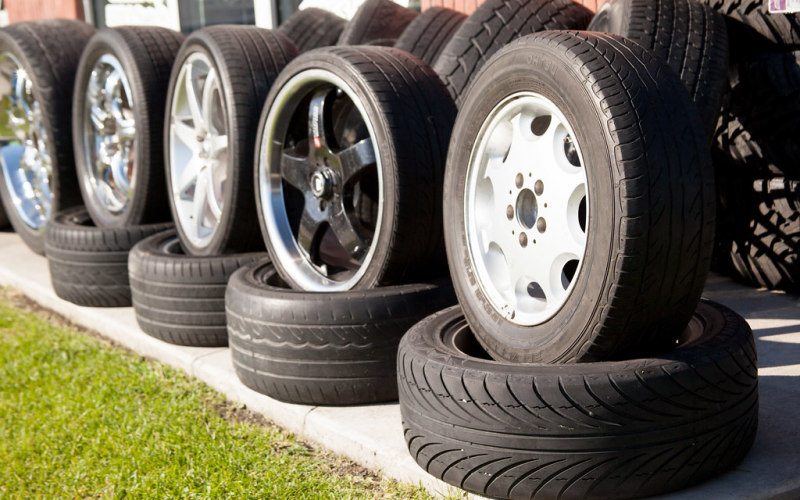Finding suitable tires and wheels for a car is an extremely responsible task because your safety on the road depends on this choice. In the automotive market, some options are suitable for various driving conditions and driving styles. Keep in mind that before choosing a specific type, you need to decide on the tire’s size. After all, if the wheels are chosen incorrectly, the controllability of the car worsens. This may cause serious damage or an accident which may cause your car to become one of the salvage cars.
Tire Markings
On each tire, you can find a lot of designations—from almost everyone’s understandable dimensions to the wear resistance index and the encrypted rubber release date. Here are the main details that you need to pay attention to when choosing tires for your car:
- Tires size. It depends on the dimensions of whether it will be possible to put the tire on the wheels of your car, and if so, whether the wheel will fit in the wheel arch. In order not to be mistaken, purchase tires of the size that is indicated in the vehicle’s instruction manual, on the tire information sticker located on the driver’s side door or in the Monroney label under Exterior.
- Carrying capacity and speed indices. For example, if we take the 94V parameter to analyze, the marking means that the maximum load on one tire is 1477 lb, according to a special table of values (code 94 corresponds to the mentioned weight index), and the maximum speed on such tires is 149 mph (in compliance with the decoding of the V mark).
- Rotation. It’s the arrow that indicates the direction of rotation of the tire when it is correctly installed.
- Inside / Outside. It indicates the inner or outer side of the tire and must be strictly observed during installation.
- The 4709 marking is an example of the tire’s manufacture date. The first two digits indicate the week of production, and the second two digits indicate the year of it. In this case, 47 weeks of 2009. It isn’t recommended to purchase tires that are more than a year old.
- Treadwear. It means the wear resistance index and directly reveals how long the rubber will last. The softer it is, the faster the tires will wear out. The index for civil use rubber is usually equal to 280 and above.
- Runflat. Tires with this marking, when punctured, retain the ability to work on a car wheel with a limited mileage at a limited speed (usually no more than 50 mph).
- AT/MT. This marking is used to indicate tires for light/severe dirt off-road driving.
When choosing the proper tires for your vehicle, pay special attention to the mentioned marking and reveal the tire parameters that suit your car.
Types of Car Tires
To make the right choice when purchasing car tires, keep in mind that they are divided into three categories, depending on the weather conditions you are going to drive in.
Summer Tires
Summer tires are designed for temperatures from 44 °F and above. These wheels have a less pronounced tread pattern. When driving in hot weather, summer tires remain cool and harden. That’s why they are perfect for fast driving on high-quality road surfaces.
Winter Tires
These tires provide maximum traction when driving on snow and ice, have a deep tread with a characteristic pattern that provides snow removal from the contact patch area, and are characterized by increased traction. The use of special components in rubber compounds helps to maintain their properties even at very low temperatures. Such tire designations are SNOW or MUD + SNOW – M+S.
Winter tires are usually used at temperatures below 23 °F. When driving in the cold, such rubber warms up and becomes elastic. Due to these features, winter tires have a more reliable grip on the road, which increases the car’s handling and reduces its braking distance. Along with that, they last longer than summer wheels but are inferior to the last ones in terms of maximum speed.
Winter tires come in three types:
- For mild winters (European type), the tread pattern resembles a herringbone. Another feature is many slots.
- For a difficult winter (Scandinavian type), the tread pattern is formed by “diamonds” arranged in a checkerboard pattern. A characteristic feature is that the elements of the picture are quite far from each other.
- With spikes for better grip on the ice surface.
Choose your winter tires carefully and in accordance with the local weather conditions.
All-Season Tires
These tires combine excellent traction on wet or snowy roads with sufficient handling, ride comfort, and tread wear resistance. Such tire designations are ALL SEASON or ALL WEATHER. They are used in the temperature range from 23 to 44 °F. Theoretically, such tires can be used all year round, which is cost-effective. At the same time, practice shows that universal tires are inferior in quality to specialized options. Such wheels provide less grip than winter tires and are heavier on the road than summer ones. Remember that all-season rubber shouldn’t be used in very cold or very hot weather.
When choosing all-season tires, make sure they are suitable for moderate climates. Quite often there are products designed for a hot climate with a small difference in air temperatures in summer and winter. Such all-weather tires for a temperate climate will not work.
Tips on Choosing Car Tires
First, pay attention to the manufacturer of the rubber. Well-known brands provide high-quality products, but such rubber will cost more than lesser-known brands with comparable characteristics. Don’t purchase tires from unknown manufacturers whose quality is questionable in terms of safety.
The high price is determined not only by the popularity of the brand. More expensive tires reduce stopping distance, noise level, and fuel consumption, as well as improve the handling and dynamic performance of the car.
Pay attention to the rating of the rubber. It indicates the place occupied by a tire of a certain model, according to the results of testing. This information is useful when comparing tires with similar characteristics and belonging to the same group. The rating helps to evaluate the quality of tires tested in practice without a detailed dive into various nuances.
Don’t install tires with different tread patterns on the car, as well as tires for different purposes. In this case, the wheels will have different grips, which is unacceptable. For uniform tire wear, you should change them in places after 6,000-9,000 miles.
When buying, pay attention to the date of production: rubber tends to age. Tires can be stored for 3 years without loss of characteristics, but only if they were always under the right conditions. Buying older tires is quite risky.
The Bottom Line
When choosing tires, you need to take into account the driving conditions and driving style. Along with that, it’s also important to pick a set that matches the plant parameters of the automobile. To maintain this, it’s useful to familiarize yourself with the characteristics of the products.




